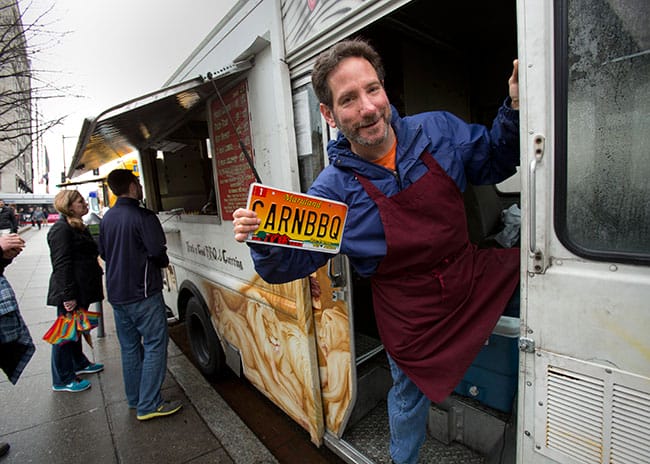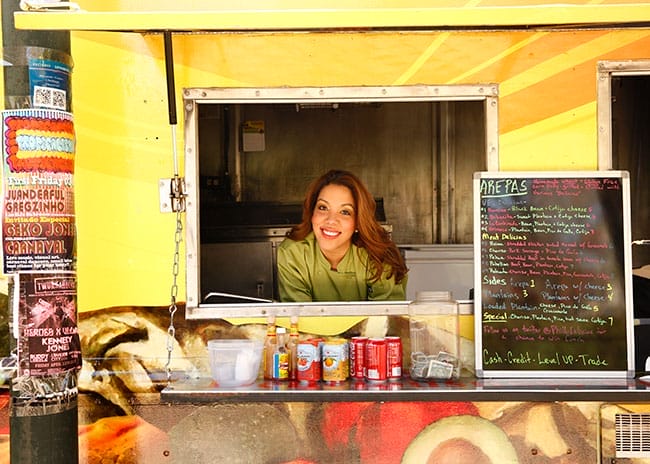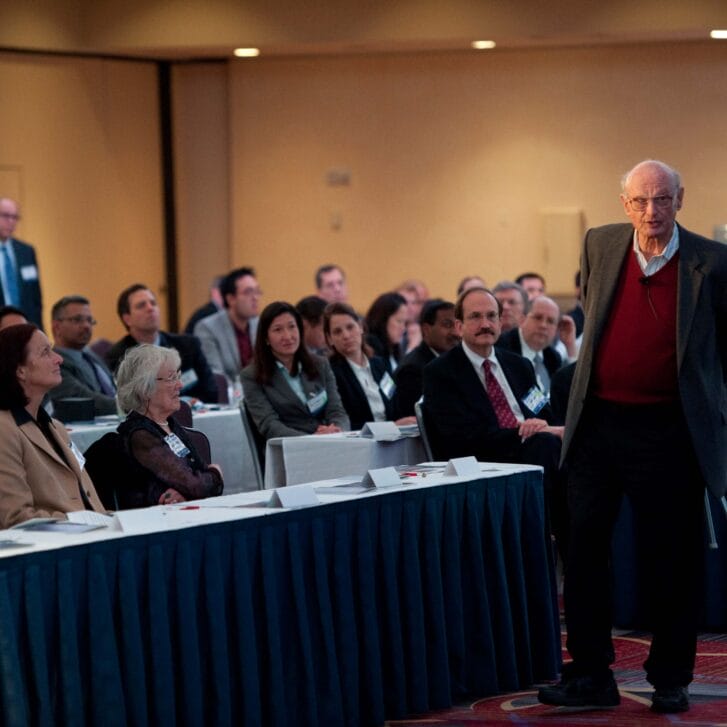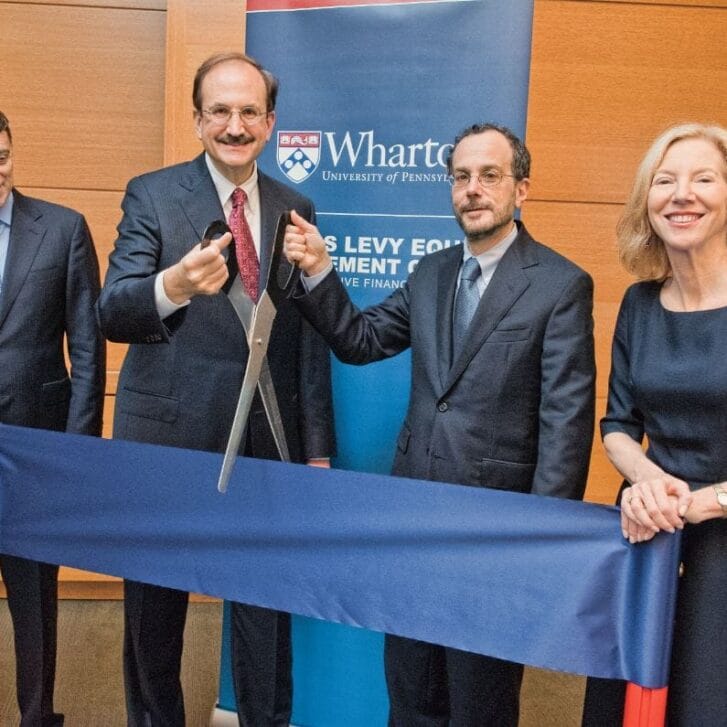Lynette Gueits-Sutton, WEV’06, never suspected that the truck that would launch her successful Philadelphia-based food business was the one she had spent months glancing at from her Penn office window, where she had been focused on AIDS research.But there it was—Delicias Food Truck. The Venezuelan woman who owned it at the time quenched hunger pangs of passersby with tasty, hand-held corn arepas heaped with homemade fillings like shredded beef, fried sweet plantains or spicy chorizo. In September 2012, the proprietor placed an ad on Craigslist to sell the truck.
Gueits-Sutton knew she needed to move quickly. There were other buyers looking to score the truck and its prime spot on 35th and Market streets. The 37-year old isn’t Venezuelan, but Gueits-Sutton caught the seller’s attention. She is of Puerto Rican descent, and she possesses an earnest desire to get a toehold in a business that has been trending since LA-based chef Roy Choi turned the food truck concept into a cultural phenomenon in 2009. Choi’s Kogi Korean BBQ truck, a Korean/Mexican fusion concept, mastered Twitter as a way to create buzz about the truck and to alert the growing crowds of customers about where the truck would be parking next. Today, there are an estimated 3 million food trucks in the U.S. Gueits-Sutton’s authenticity cinched it.
“The woman who owned the truck asked me if I could ensure that the integrity of the brand was maintained. I said, ‘You better believe it.’ I purchased the entire business [for $37,000], and kept on her two employees,” Gueits-Sutton says.
The two sat down to exchange tips on preparations and fillings, and by September 2012, Gueits-Sutton was peddling tasty Latin food in a freshly rebranded truck near the Penn campus. Her concept of Delicias Food Truck is straightforward— “deliciousness on wheels”—and resonates with customers. So much so, that within weeks of launching the first truck, Gueits-Sutton went back to Craigslist again in search of a second. She bought another truck for $55,000, and by January 2013, it was fully inspected and up and running.
Gueits-Sutton knew her food had to be good, but she also understood that her fledgling business required a strong and creative presence on social media platforms like Twitter, Facebook and Instagram. She created a loyalty program to entice repeat customers, and she leaned on what she learned at Wharton to prepare her entry into the business.
“I don’t come from a family of entrepreneurs,” Gueits-Sutton says. “Wharton helped to develop and inform my business strategy. It’s not just introducing a product and maintaining existing products—it’s important to acquire new customers. That’s the key to the kingdom.”
Gueits-Sutton is confident she’s hit the sweet spot and is actively expanding again.
In December 2013, she opened a 26-seat, brick-and-mortar restaurant in Old City Philadelphia, serving up the cuisine she’s become known for, and she is now looking into a kiosk concept at PHL airport.
COUP ON FOUR WHEELS
For Jeff Henretig, WG’09, the attraction began during his time at Wharton as a growing awareness of some of the problems associated with our nation’s food system. Influenced by Michael Pollan’s In Defense of Food and T. Colin Campbell’s The China Study, Henretig pondered issues of processed foods, meats and dairy, and of broader health and environmental ideas that support a vegetarian-focused diet.
Those concepts became the steppingstone to his Coup de Taco food truck. A clever play on the phrase coup d’état, the only thing overthrown in this concept was the traditional taco format. Instead, the food came with an international twist. Think Tiki masala tacos, sweet Thai coconut-themed tacos complete with peanut sauce or tacos made from savory pork mole.
As his MBA graduation crept closer, Henretig and two childhood friends, Peter Berman and Richie Lopatin, connected at the wedding of Jason Barg, WG’09, a high school pal and Henretig’s roommate at Wharton. As it turned out, they shared his preoccupation with a healthy food concept.
“My favorite food tends [to be] local Indian, Thai or Mexican restaurants. They captured exactly what I was looking for: It’s a hot meal. It’s spicy. Interesting. You get some meat and all these salsas or sauces, onions, peppers, rice and other components that have real nutritional value coming from the vegetables, but it’s not just a salad,” he explains.
Henretig and his partners met regularly to fine-tune details of their new business. None of them had significant hospitality experience, but the three were ready to take a risk. Henretig had a management consulting job offer in New York on the table, but convinced the company to postpone his start date so he could give the truck a chance. The partners each came up with $11,500, paired that with a $2,500 grant from the Wharton Venture Initiation Program, and together launched Coup de Taco in October 2009.
They found and refurbished an existing food truck on Craigslist. But even with new propane lines and new electrical wiring, there were some hurdles.
“The tiny little serving window was on the wrong side of the truck for where our permit gave us a location,” Henretig gives as illustration.
There was no time for a stress-free soft opening. Word about the new truck spread among friends on Facebook. In the first month, they were asked to participate in Bloktoberfest in Philly’s Graduate Hospital neighborhood, where they were expected to help feed the thousands of people gathered to hear live music and cele
brate.
“It was scary,” Henretig recalls. “We had done a few tastings with family and friends to test recipes, but that first event was huge. I multiplied recipes by 15 instead of by three.”
Eventually, life changes. Career moves and the loss of the kitchen space called Philly Kitchen Share on South Street (now closed)—which they had been using to prep ingredients before taking the truck out each day—meant Henretig and his partners were faced with a decision: Find a new kitchen and expand, or fold the business. They chose the latter.
Henretig now runs his own New York-based consultancy focusing on management strategy for small businesses and says the lessons learned while operating Coup de Taco were invaluable for his current pursuit.
“On-the-ground lessons are hard to come by until you’ve actually done it,” he says.

Stephen Adelson, WG’90, serves up authentic BBQ to lines of hungry DC diners. (Photo: Mark Finkenstaedt)
RECIPE FOR CURB APPEAL
For Stephen Adelson, WG’90, serving food from a truck was the siren call of rich, delicious barbecue, cured over hard woods like hickory, cherry and apple, that hooked him hard. Barbecue had long been a family passion shared over piles of finger-licking spareribs, but it wasn’t until years later, when Adelson went to visit his brother in Oakland, Calif., that his eyes were opened to the idea that barbecue could be so much more.
“We went to a place called Flint’s Bar-B-Q that’s no longer there, but that was the first time I had real barbecue cooked solely with wood. Their hot sauce was so hot, you couldn’t eat it straight. You’d have to mix it with the mild. That place had a profound effect on me,” he says.
That moment of clarity is when Adelson realized he could stand out among the food truck competition. At the time in Washington, D.C., that included a lobster roll truck, a vehicle selling Indian and Ethiopian food, and a Mexican-Korean fusion concept. He had dabbled in the food business for years—wholesaling bagels, even giving a Peruvian chicken restaurant a go—but it wasn’t until he followed his passion for smoky, fall-off-the- bone meat that a concept stuck, and the Carnivore BBQ truck was born.
In 2010, he started with an old-style “roach coach” kind of truck in D.C., but by 2012, he realized it didn’t have the same draw as the updated step-van trucks he was competing against. He had great product and great reviews, but …
“We just didn’t have the curb appeal. It was demoralizing,” he says.
His new truck, sporting a mural of a ravenous, meat-eating lion, changed all that. It enticed the D.C.-area lunch crowd and sealed his reputation as a skillful pitmaster, which helped him score a coveted invitation to feed the crowds at President Barack Obama’s second inauguration.
“We were inside the security [perimeter] and served thousands that day. Literally thousands,” he says, including purportedly (and without confirmation) the president.
Like most food-centric business, margins are tight, and meat is expensive. What makes the competition particularly tough is that few to no barriers exist to entrants, creating what Adelson calls a “perfect competition” scenario. City regulations increased the pace. Prior to 2013, vendors could park anywhere in D.C.’s central business district. There would be a mad-dash among vendors to get prime spots early. (By December 2013, the city went to a lottery system with assigned parking and assigned days.)
Adelson understands that to be both competitive and profitable, it is important to keep the menu focused and simple. Pulled pork, beef brisket and smoked chicken—or any combo of those— come with a choice of nearly ahalf-dozen house-made sauces. He pairs them with traditional sides like loaded smoked beans and a cabbage-based coleslaw that Adelson boasts is the second most downloaded recipe in the history of the Washington Post’s food section.
He also diversified—with four trucks and a fifth on the way. He hasn’t unveiled the name of the new truck just yet (OK, maybe he told us but we’re sworn to secrecy), but he’s staying decidedly true to his focus on American comfort food (Hint: macaroni and cheese.)
It also means he won’t be giving up the food-truck lifestyle anytime soon.
“It certainly is a great cover for a midlife crisis,” says the 51-year-old. “Where else can you go out and make the food you’re passionate about making, serve it to people passionate about eating it, in a truck that you designed that is literally a driving artistic masterpiece, and listen to the Grateful Dead all day while doing it?”
DOLLOP OF TECHNOLOGY
Adiano Blanaru, WG’10, saw an entirely different opportunity in leveraging the food truck trend. Frustrating waits for food orders and other customer inconveniences made this niche ripe for a technology-inspired solution focused on efficiency.
Blanaru and two tech-friendly Wharton classmates knew the answer likely lay in their smartphones—which at the time, in 2008, were still novelties. (To help put that into perspective, the iPhone was introduced in June 2007.)
Their idea? To build a tool that gave customers the ability to order food online or through their phones and pay by credit card, which would include a small “convenience fee” that funded their new business, FoodTrux.com.
Online food ordering and delivery services like GrubHub or Seamless were already taking root in cities like Los Angeles, Boston and New York. Blanaru sensed the buzz, but he knew the market for online ordering from traditional restaurants was getting saturated. Opportunity, he thought in late 2008, rested on the wheels of food trucks.
“The focus was helping the food trucks operate in a more efficient way so long lines wouldn’t form at lunch,” says Blanaru.
Penn’s campus was their testing grounds, and at its peak, FoodTrux.com counted up to eight food trucks as customers. Cuisines included Mexican, Chinese, Caribbean, sandwiches and even Henretig’s Coup de Taco truck.
But typical of many startups, hiccups happen. Food truck operators sometimes neglected orders sent in online, focusing instead on customers standing in front of them. Sometimes the trucks didn’t show up. Operators didn’t always speak English. Convincing enough trucks to sign on to the service was a tough sell; in addition, convincing customers to plan ahead, place orders early and pay a fee was its own hurdle.
Their ordering concept lasted a year, when the team finally came to the conclusion that the vendor acquisition costs were too high. The business could not be financially viable on a small scale; a market of thousands of trucks would be needed.
“I think the main lesson we learned is it doesn’t matter how good your idea is—changing behavior is always hard,” he says.
Still, the experience was immensely valuable. Blanaru didn’t stray far from the tech world. Today, he’s a senior product manager at the Bay Area-based Hightail (formerly YouSendIt). He hasn’t strayed far from food trucks either.
“I eat at food trucks every time I get the chance,” he said.

























